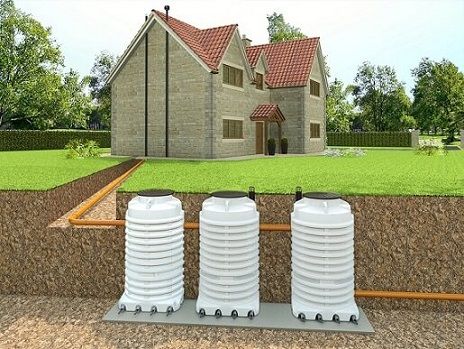Non-Electric Sewage Treatment Systems | Eco-Friendly | WTE
FilterPod Non-Electric Sewage Treatment Plant
Our FilterPod sewage treatment system does not need electricity to power the treatment process. It uses natural air currents to aerate the sewage and treats it using simple filtration. See how much you can save.

How Sewage Systems Work
All sewage treatment systems work by using naturally occurring aerobic (oxygen breathing) bacteria to digest the pollutants in the sewage. In order for the aerobic bacteria to live, oxygen must be available for them to breathe.
Electric Systems
All electrically operated treatment plants use electricity to aerate the sewage liquid. This is done by one of the following methods:
- Rotating discs through the sewage, by means of a motor/gearbox inside the plant. These discs are half-submerged in the liquid sewage. Aerobic bacteria grow on the discs and take in oxygen when the disc rotates out of the liquid. They are an old technology, now made by only one manufacturer.
- Pumps which spray liquid sewage over plastic shapes, with a lot of surface area, called 'Media'. The sewage liquid takes up oxygen during the spraying process and bacteria grow on the media surface. They absorb the oxygen and digest the sewage pollutants as they wash over them. This is also old technology, uses a LOT of electricity and manufactured by only one company now.
- Air blowers which bubble air through the sewage liquid. The sewage liquid may, or may not have media added to it. If the liquid has media within the biozone chamber, then the plant is called a 'Submerged Aerated Filter' (SAF) and if it doesn't, it is likely to be an Activated Sludge' treatment system. The latter is the most modern type of treatment plant.
FilterPod Non-Electric Sewage Treatment Plant
The FilterPod is a Filter System. The sewage flows from the house to a 2 stage settlement tank, to separate the solids from the liquids and the liquid effluent then flows to the tank that contains the filter, or multiple filters. These plants use RDX filter media. This is specifically manufactured for long term foul water filtration and is cheap to replace when the time comes, which is annully for the top layer of media sacks.
The sewage liquid flows through the RDX media, which traps the pollutant particles. Air is supplied through air channel passages and penetrates the filter material. The aerobic bacteria that develop then have air and food and they digest the pollutants.
Performance of Non-Electric Sewage Treatment Systems
The performance of non-electric systems varies enormously between the makes. One Non-Electric plant only just scraped through he EN 12566-3 Test, with Ammoniacal Nitrogen levels right on the limit of what is allowed in the UK. See sewage treatment plant SELECTION.
Another manufacturer made sure that their plant was tested through a German Summer, as higher temperatures make all plants work far more efficiently - but your plant has to work during the winter as well.
One manufacturer also sells their smallest plant as a 6 person, when it was only tested with 750 litres of sewage per day - enough sewage for 5 persons (5 x 150 litres/person/day), but not for 6. No wonder that the Test Results are good as it was under-loaded.
We insisted that FilterPod was tested through a German Winter instead, where temperatures are below freezing for much of the time. It was also tested for the correct number of people.
Be very careful when choosing a non-electric plant, as it is a minefield.
Installation Costs
Non-electric sewage treatment systems are no more expensive to install than electric ones.
Maintenance and Servicing
Contrary to the various manufacturer's claims, all filters block over time and cannot 'self-clean' adequately to avoid filter replacement. The filter media must be partially replaced every year and fully replaced every 10 years. The cost of FilterPod media is about £50/year.
Servicing costs for ALL non-electric plants must be carried out annually. This costs about the same as for an electric plant..
